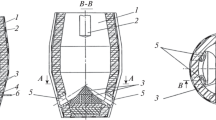Abstract
The paper presents results of testing semi-coke as a carbon reducing agent in the production of manganese and silicon alloys. The fundamental possibility of using semi-coke in the carbon part of the charge as a basic reducing agent to produce ferrosilicon manganese is established. It is noted that a new reducing agent in its pure form works worse than in a mixture with coal. The greatest synergistic effect in the production of ferrosilicon manganese was achieved during the interaction of semi-coke with coal, while the following indicators were obtained: maximum furnace productivity of 43 t/day, maximum extraction coefficient of 87.9%, and minimum specific dust formation of 49 kg/t of alloy. In the production of ferrosilicon, the use of a new reducing agent did not give a significant positive effect, due to its low structural strength. It was revealed that the structure and type of the reducing agent affect the furnace performance: when using a reducing agent with a higher reactivity in the charge, it is possible to obtain higher furnace performance. In the production of ferrosilicon, a change in the specific dust generation is closely related to the level of daily production and specific energy consumption and can serve as an indicator of furnace operation. The furnace performance, ceteris paribus, is determined by the amount of useful power input. With an excess of carbon in the charge an increase in useful power leads to a slight increase in the furnace performance, but at the same time, the energy consumption and specific dust formation significantly increase. It is shown that the influence of technological factors on the technical and economic indicators of melting is determined by the degree of electrode seating in the furnace.



Similar content being viewed by others
REFERENCES
Galevskii, G.V., Anikin, A.E., Rudneva, V.V., and Galevskii, S.G., The use of lignite semi-coke in metallurgy: technological and economic assessment, Nauchno-Tekh. Ved. S.-Peterb. Gos. Politekh. Univ., 2016, no. 2 (243), pp. 114–123.
Ryabov, V.A. and Stolbova, O.B., Modern industrial complex of Kemerovo region, Vestn. Kemerovsk. Gos. Univ., Ser.: Biol., Tekh. Nauki Nauki Zemle, 2017, no. 3, pp. 41–46.
Strakhov, V.M., Problems with carbon materials in ore and chemical electrofurnaces, Coke Chem., 2010, vol. 53, no. 8, pp. 301–304.
Luo, Y.H., Zhu, D.Q., Pan, J., and Zhou, X.L., Utilization of semi-coke as by-product derived from coal-based direct reduction process in iron ore sintering, Ironmaking Steelmaking, 2016, vol. 43, no. 8, pp. 628–634.
Pistorius, P.C., Reductant selection in ferroalloy production: the case for the importance of dissolution in the metal, J. South Afr. Inst. Min. Metall., 2002, vol. 102, no. 1, pp. 33–36.
Koursaris, A. and See, J.B., Reactions in the production of high-carbon ferromanganese from Mamatwan ore, J. South Afr. Inst. Min. Metall., 1979, vol. 79, pp. 149–158.
Cheng, A., Coke quality requirements for blast furnaces. Part I, Iron Steelmaker, 2001, vol. 28, no. 1, pp. 30–32.
Ishii, K., Preface to the special issue on innovative ironmaking reactions in new BF to aim at halving energy needs and minimizing environmental load, ISIJ Int., 2004, vol. 44, no. 12, pp. 1969–2178.
Ishii, K. and Yagi, J., Basic research on ironmaking process in blast furnace and development in near future, Tetsu-to-Hagane, 2001, vol. 87, no. 5, pp. 207–220.
Khanna, R., Sahajwalla, V., Rodgers, B., and McCarthy, F., Dissolution of carbon from alumina-carbon mixtures into liquid iron: influence of carbonaceous material, Metall. Mater. Trans. B, 2006, vol. 37, no. 4, pp. 623–632.
Gudenau, H.W., Meier, L., and Schemmann, V., Coke quality requirements for modern blast furnace operation, Proc. 57th Ironmaking Conf., Toronto: Iron Steel Soc., 1998, pp. 1067–1072.
Kim, V.A. and Ul’eva, G.A., Comparative evaluation of the structure of special cokes used in electrothermics, Vestn. Magnitogorsk. Gos. Tekh. Univ. im. G.I. Nosova, 2012, no. 2, pp. 20–23.
Strakhov, V.M., Surovtseva, I.V., Elkin, D.K., Elkin, K.S., and Cherevko, A.E., Low-ash carbon reducing agents for electrothermal silicon production, Coke Chem., 2012, vol. 55, no. 5, pp. 172–175.
Strakhov, V.M., Alternative carbon reducing agents for ferroalloy production, Coke Chem., 2009, vol. 52, no. 1, pp. 19–22.
Nefedov, P.Ya., On the quality requirements of carbonaceous reducing agents for ore electrothermy, Koks Khim., 2000, no. 8, pp. 24–32.
Dijs, H.M. and Smith, D.J., Factors affecting the resistivity and reactivity of carbonaceous reducing agents for the electric-smelting industry, J. South Afr. Inst. Min. Metall., 1980, vol. 80, no. 8, pp. 286–296.
Feng, B., Bhatia, S.K., and Barry, J.C., Structural ordering of coal char during heat treatment and its impact on reactivity, Carbon, 2002, vol. 40, no. 4, pp. 481–496.
Soundara, R.M., Somu, M., Ganapathik, and Malarkkan, K.M.V., Thermal analysis-approach to coal reactivity studies, Indian J. Power River Valley Dev., 1980, vol. 30, nos. 11–12, pp. 148–162.
Miura, S. and Silveston, P.L., Change of pore properties during carbonization of coking coal, Carbon, 1980, vol. 18, no. 2, pp. 93–108.
Golitsyn, M.V., Vyalov, V.I., Bogomolov, A.Kh., Pronina, N.V., Makarova, E.Yu., Mitronov, D.V., Kuzevanova, E.V., and Makarov, D.V., Prospects for technological use of coals in Russia, Georesursy, 2015, vol. 61, no. 2, pp. 41–53.
Ugol’naya baza Rossii. Tom 2. Ugol’nye basseiny i mestorozhdeniya Zapadnoi Sibiri (Kuznetskii, Gorlovskii, Zapadno-Sibirskii basseiny; mestorozhdeniya Altaiskogo kraya i Respubliki Altai) (Coal Resources of Russia, Vol. 2: Coal Basins and Deposits of Western Siberia (Kuznetsk, Gorlovsky, West Siberian Basins; Deposits of the Altai Krai and the Altai Republic)), Moscow: Geoinformtsentr, 2003.
Balmasov, N.N., Branchugov, V.K., Bykadorov, M.V., et al., Mineral’no-syr’evaya baza ugol’noi promyshlennosti Rossii. T. 1. Sostoyanie, dinamika, razvitie (Mineral Resources of the Coal Industry of Russia, Vol. 1: State, Dynamics, and Development), Evtushenko, A.E. and Malyshev, Yu.N., Eds., Moscow: Mosk. Gos. Gorn. Univ., 1999.
Author information
Authors and Affiliations
Corresponding authors
Additional information
Translated by S. Avodkova
About this article
Cite this article
Shubina, A.A., Zhuravleva, N.V., Korotkov, S.G. et al. Technological Suitability of Semi-Coke as a Carbon Reducer in Production of Manganese and Silicon Alloys. Steel Transl. 50, 445–451 (2020). https://doi.org/10.3103/S096709122007013X
Received:
Revised:
Accepted:
Published:
Issue Date:
DOI: https://doi.org/10.3103/S096709122007013X



